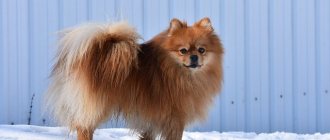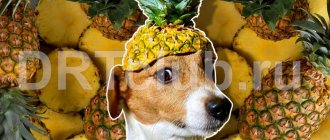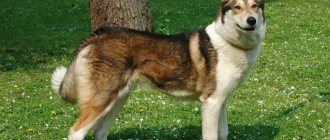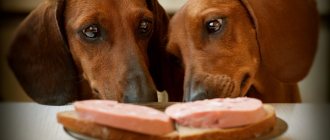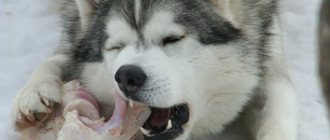Pomeranians are an absolutely picky breed when it comes to food. They will eat whatever they are taught to eat from childhood. The owner chooses what to feed the Spitz himself. You can turn your pet into a picky eater by spoiling him with a wide variety of foods. Or accustom him to a certain diet, which he will get used to and eat with pleasure.
The basis of the diet - what do Pomeranians eat?
A complete diet of oranges should include lean meat. It is better to feed raw or slightly scalded meat after freezing. It is recommended to replace meat with offal 2-3 times a week. When feeding natural food, preference is given to chicken, turkey, and beef. Meat should be given to your pet in the form of cut pieces. Meat in the daily menu of a miniature spitz should make up 50–60% of the total food volume. The rest of the menu may consist of fish, cereals, dairy products and eggs, and plant products.
Allowed and prohibited products for oranges
Permitted products include:
- lean meat;
- ocean and river fish;
- seafood;
- cereals: rice, buckwheat;
- milk, dairy products, eggs;
- vegetables: carrots, pumpkin;
- fruits: apples, pears, gooseberries, banana.
Products that are prohibited from feeding a dwarf Spitz:
- meat high in fat: pork, etc. and fatty fish: mackerel, etc.
- citrus fruits, grapes;
- oatmeal and semolina;
- sausage, salty, spicy and fried foods;
- chocolate;
- mushrooms;
- chicken tubulars and spicy beef bones.
It is forbidden to give any boiled bones, as they are not digestible.
General recommendations and nutritional standards for Pomeranian Spitz
When feeding your Pomeranian Spitz, adhere to the following standards and recommendations:
- Your pet should have purified drinking water available at all times. It should be changed daily;
- for bowls, you need to use a special stand, adjusted to the height of the dog, so that the posture does not become distorted;
- Do not mix natural food and dry food. Either one type of food is established, or they give ready-made food in the morning, and natural food in the evening;
- The required amount of food is selected according to the weight of the orange. With a natural diet, you need 20 grams of meat; the required amount of ready-made food that Pomeranians eat is indicated by the manufacturer on the packaging. This is approximately 80 to 150 grams per day;
- food should be at a temperature of 20 -25 degrees, it is forbidden to serve hot or cold;
- a separate menu is prepared for Pomeranians; feeding from the table can shorten the pet’s life;
- With a natural type of nutrition, cereals are cooked in water. Then mix them with other products and raw meat, you can add broth;
- The Pomeranian should be satisfied immediately after eating. If your pet does not eat everything, then the serving size should be reduced. If he eats willingly and quickly eats everything, then the amount of food needs to be increased;
- food must be fresh; The Pomeranian should eat it within 15 minutes;
- If you plan to switch your Miniature Spitz to another type of food, do it gradually, spreading the transition over 2–3 weeks.
Is it possible to mix
You can often hear that it is not recommended to change dry food throughout life and not to mix dry food with regular (natural) food. However, many breeders believe that alternating food from natural products with industrial food is acceptable. It’s just important not to mix them into one feeding. It is a mistake to believe that a mixture of porridge and croquettes will give the dog more benefits and fill it up faster.
You can mix wet food with kibble from the same manufacturer. However, there is a drawback - this significantly increases the cost of feeding.
There are canned foods into which it is permissible to add boiled cereals, usually rice porridge or buckwheat. It's written on the cans.
If your pet doesn’t eat one food well, you have to switch to another. This is done gradually. The digestive system does not adapt immediately. It will take several days. On average, the translation process takes a week.
How many times a day should puppies and adult Pomeranians be fed?
Let's look at the nutrition and maintenance of adult Pomeranian Spitz dogs and puppies. The number of meals is determined by the age of the dog. Pomeranians are fed several times a day: up to two months - 6 times, up to three months - 5 times, up to six months - 4 times, up to eight months - 3 times, adult miniature spitz - 2 times a day.
In some situations, the frequency of feeding is changed. In hot weather, as well as for sick Pomeranians, reduce the number of servings. And in cold weather, as well as for lactating or pregnant bitches, increase the number of servings.
You should always feed your dog after a walk or at least 2 hours before a walk. An adult Pomeranian is fed in the morning and evening, puppies, depending on their age, at equal intervals.
If your pet refuses to eat: possible reasons
Spitz are lovers of food, so refusing to eat can be a cause for concern for owners. But this phenomenon does not always signal the presence of a disease in the pet. Here is a list of possible reasons why your Pomeranian may have a decreased appetite:
- dogs have a “fasting” day every few months;
- stressful situation;
- hot weather;
- desire to get more tasty food;
- problems with the gastrointestinal tract;
- parasites;
- mite;
- oral injuries;
- allergy.
Important! If the owner notices that the dog has a poor appetite, it is worth contacting a veterinarian. He will be able to determine the exact reason for refusing to eat and give recommendations on how to eliminate it.
Spitz is unpretentious in food, so owners do not need to look for special foods or rare food. But to maintain a beautiful coat, the pet must receive a sufficient amount of vitamins. Like most representatives of miniature breeds, Spitz dogs have a sensitive gastrointestinal tract, so you should choose low-calorie foods.
How to create a diet of natural products for your Pomeranian
The menu for natural feeding consists of the following categories of products that Pomeranians consume:
- meat and offal;
- fish;
- cereals;
- dairy products, eggs;
- vegetables.
Healthy meat and offal
Orange meat is fed with: lamb, beef, veal, turkey, chicken. The fillet is cut into fairly large pieces so that the pet can chew it and train its jaws. The meat is given raw, kept in the freezer for about a day; you can also scald the meat with boiling water. It should be noted that some dogs may be allergic to chicken. By-products used for food include: ventricles, tongues, heart, tripe. They are also fed raw, having previously been chopped into pieces. You can also give liver, but in small portions, so as not to provoke diarrhea.
Fish menu
The Pomeranian menu can include both sea and river fish. It is advisable to give fish without bones. Sea fish can be fed both raw and slightly cooked. Suitable for constant feeding: cod, pollock, hake. You should not give your Miniature Spitz fatty fish such as mackerel and herring. River fish should not be given raw to avoid infection with worms. Be sure to boil it well.
Suitable grains for Pomeranians
Rice and buckwheat boiled in water without salt or with a small amount of it. Sometimes you can diversify the menu with wheat porridge.
Milk-based products, eggs
The orange's diet should include fermented milk products: kefir, yogurt, natural yogurt and cottage cheese, but with a fat content of no more than 10 percent. Small Pomeranians can also be given cottage cheese. You can also feed some cheese. You can also pour milk for your dog if it doesn’t upset his stool. You can add boiled chicken eggs to your food. In its fresh form, protein is not absorbed in the dog’s body.
What vegetables can a Pomeranian spitz eat?
Oranges can be given vegetables as a source of fiber for normal intestinal function. Vegetables are also recommended for the diet if your pet is obese. You can feed your pet carrots, beets, spinach, zucchini, pumpkin, sauerkraut and stewed cabbage - raw or steamed.
Benefit
The apple is considered the safest and most accessible fruit for dogs in our latitudes. It is this, together with carrots, in grated form, that serves as the first complementary food for the puppy, guaranteeing proper development of digestion and access to vitamins. It is impossible to completely abandon it in the diet (unless the pet has an allergy).
The benefits of apples are undeniable:
- A valuable source of carbohydrates and fiber that improves intestinal function. With regular use, the incidence of constipation and diarrhea will be reduced.
- They contain vitamins C, B1, B2, P, E, strengthen the immune system, reduce the risk of contracting infectious and viral diseases.
- There are trace elements: manganese, iron and potassium. The latter is considered vital for dogs: it ensures the proper functioning of muscles and nerves. And apples, along with carrots, pumpkin and bananas, can increase potassium intake in dogs. Iron fights the development of anemia - this is also possible in dogs.
- Regular consumption of apples will strengthen the animal’s gums and teeth. When chewing fruit, the necessary load will be placed on the chewing organs. And the acid contained in apples will perfectly cleanse the enamel of plaque and even germs. Apples also contain calcium, which is good for teeth.
Plus, it's a great treat. It is much healthier than the cheese and chocolate revered by pets, and can be used as rewards. And the fact that dogs really like this fruit is evidenced by the fact that a number of popular treats for dogs contain apple flavoring.
By introducing an apple into a dog’s diet, the owner can be sure that his pet will be in a good mood and without health problems.
Pros and cons of feeding Pomeranians natural food
Pomeranian dogs can be fed natural food; this type of feeding has its pros and cons.
Advantages:
- the pet owner knows what he is fed because he chooses the products;
- natural products contain virtually no dyes or preservatives;
- if an allergy occurs, you can easily determine which product caused it and not give it anymore;
- Natural products are high in protein, fat, carbohydrates, and fiber.
Flaws:
- cooking food at home takes a lot of time;
- the owner will have to look for and select the right products himself, create a diet so that the orange’s body receives all the necessary elements according to the norm;
- when feeding natural food, it is recommended to add additional fertilizer;
- the cost of natural food is higher than that of prepared feed;
- inconvenient for travel, as it is difficult to find a place to prepare food.
Harm
All of the above does not mean that you should switch your pet exclusively to a fruit diet.
In large quantities, apples can cause harm to animals.
Firstly, coarse fiber, which is so abundant in an apple, can only be beneficial in small doses. An excess of fiber in the body will lead to the active elimination of toxins and waste. The animal will begin to lose weight, suffer from colitis, and indigestion. An excess of apples also leads to fermentation in the stomach and increased gas formation.
Secondly, a large dose of fruits and vegetables, in particular apples, can cause diarrhea in the animal, which can lead to dehydration. If you overfeed apples, you will not be able to do without the help of a veterinarian.
Allergy
Allergy to apples is a rare type of allergic manifestation. It does not happen in animals. If a dog begins to itch after eating a piece of fruit, this is a sign that the product was of poor quality.
Store-bought apples are dangerous to give to dogs: their skins may retain chemicals that were sprayed on them for preservation or growth. Also, sometimes fruits are coated with a special paraffin composition, which makes them more attractive in the eyes of buyers, but at the same time can provoke allergies.
Important: there is no food allergy to yellow and green apples. But red fruits can contain a strong allergen.
Weekly sample menu
You can feed oranges by day of the week approximately as follows, according to the table:
| Day of the week | What to feed your Pomeranian |
| On Monday: | cereals, meat, fruits. |
| On Tuesday: | fermented milk, offal, greens. |
| On Wednesday: | cereals, seafood, meat. |
| On Thursday: | fermented milk, fish, vegetables. |
| On Friday: | fermented milk, meat, fruit. |
| On Saturday: | offal, vegetables, meat, herbs. |
| On Sunday: | cereals, fish, fruits. |
Which dry food to choose for your Pomeranian
Pomeranian Spitz can also be fed with dry food, let's look at how to do it correctly. The advantages of feeding dry food: no need to waste time preparing and combining the diet, convenient to store, no additional feeding required.
You cannot feed your Pomeranian with cheap food. They contain vegetable protein and soy with corn. Plant protein cannot meet the need for animal protein. Soy causes allergies. Corn quickly saturates the body, but causes digestive problems. When buying ready-made food for your Miniature Spitz, you need to rely on the following factors:
- the food must contain at least 25 percent protein or protein of animal and plant origin;
- good dog food contains meat and fish;
- An essential component of dry food is vitamins A, D and group B.
Minerals and carbohydrates are contained in the required quantities in any feed, since these are cheap components.
Having chosen the appropriate food for your orange, you should feed it according to the instructions on the package. Veterinarians do not recommend changing food frequently without good reason. The best choice for the breed is holistic or premium food. These foods are more expensive than regular supermarket foods, but they will improve your dog's health.
Holistic food for oranges:
- Canidae
- Grandorf.
- Eagle Pack Holistic.
- Wellness.
- Chicken Soup.
Premium food:
- Eucanuba.
- Optima Nova.
- Iams.
- Nutro nuggets.
- Pro Pac.
Do you need variety?
Spitz, like other dogs, do not require variety. If you decide to feed your Spitz only dry food, it is not advisable to conduct experiments and test a new brand every week.
There are brands of dry food that have proven themselves. First, it is better to buy dry food for your Spitz in small quantities - for a week. If the croquettes are eaten with pleasure and do not cause digestive problems, you can feed them for another month. If the number of trips to the toilet does not increase, the pants are clean after a walk and the pet is happy with everything, leave the food.
If the dog does not eat well, they gradually switch to kibble from another manufacturer. If the Spitz does not eat dry food at all, then there is only one alternative - natural food.
How to properly feed a Pomeranian Spitz natural food
If you choose a natural type of nutrition, it is important to provide fresh foods. Approximately 35 percent of the diet is protein food: lean raw meat, dairy products, boiled chicken eggs, and you can also feed the dog lean, boneless fish 2 times every 7 days. About 10 percent of the diet is cereals cooked in water. As a source of fiber and carbohydrates, the miniature spitz is given vegetables and fruits: zucchini, cucumbers, carrots, cabbage, apples, pears, bananas. With a natural type of nutrition, oranges should be supplemented with vitamin complexes. You need to select supplements with your veterinarian.
What to feed your Pomeranian during pregnancy and the postpartum period
The nutrition of the female orange is important for the formation of future offspring. Depending on the stage of pregnancy, the diet changes. In the first month, nutrition remains the same, as the embryos develop slowly. From the second month, the female needs to be fed more than usual: 3 times a day, as she needs more nutrients. There must be balance in nutrition. If there is a lack of minerals, the substances will only be used to form the skeleton of the puppies. This can weaken the dog. Therefore, you need to select a vitamin supplement with your veterinarian. You need to switch to a high-calorie diet from 6 weeks. If you are unable to prepare food, you need to purchase special food for pregnant dwarf dogs. During the first six hours after birth, it is better to give the dog only water; you can give chicken broth.
How to properly feed a Pomeranian puppy
The puppy requires careful care. Proper nutrition is the key to good health.
A good food for a puppy of this breed will provide him with all the necessary elements. Let's look at what you should feed your orange puppy at different ages. We will also consider the amount of food needed when feeding a Pomeranian puppy.
Under one month of age
The breeder takes care of the little Pomeranians for up to a month. During this period, the puppies remain in the care of their mother and until 21 days they must eat only mother's milk.
Feeding a month old Pomeranian
The food norm for a one-month-old Pomeranian puppy is: 40 grams of meat, 20 grams of vegetables and fruits, 30 grams of fermented milk, 20 grams of cereal. The babies are fed 6 times a day. And also at this age they still continue to feed on their mother’s milk.
What to feed a 2 month old Pomeranian puppy - main menu
The owner has to feed a small two-month-old Pomeranian Spitz, since puppies are given away at two months of age. You need to feed the puppy 5 times a day in small portions. The daily menu consists of 50 percent meat, the rest cereals and vegetables. The weight of the portions is the same as for a one-month-old puppy, plus 10–20 grams. Food for a two-month-old puppy: food softened with water, buckwheat porridge with pieces of meat, grated apple, low-fat kefir, cottage cheese.
Pomeranian diet at 3 months
At 3 months old, a orange puppy can also be fed boiled sea fish without bones. You cannot feed river fish without steam treatment, as the helminths living in it can harm the puppy’s body. At three months of age, puppies should eat four times a day. You can add to the menu: zucchini, carrots, beets, boiled chicken, cut into pieces and boiled chicken eggs, up to two per week. We increase the daily norm by another 40 grams for meat and by 20 grams for everything else.
What to feed a 4 month old Pomeranian puppy
Feeding a Pomeranian at the age of 4 months is carried out 3-4 times a day.
The daily amount of meat for a Pomeranian puppy is calculated according to the formula 25 grams per kilogram of weight. It is better to exclude foods with a high content of vitamin C, since it is produced in the body. At four months, puppies eat the following foods: buckwheat, brown rice, wheat porridge, fermented milk products up to 9% fat, vegetables, fruits, fish and fish oil. The serving size of fish should be twice as large as meat, since the nutritional value of fish is less.
What to feed a 5-6 month old Pomeranian puppy
The nutrition of a Pomeranian Spitz puppy at the age of 5 months is the same as at four months, only the number of meals is reduced to 3 times. You can start giving your puppy soft bones without sharp edges. Puppies can also eat cartilage.
What to feed a Pomeranian from 6 months to 1 year
The portion size remains the same, and since the puppy is no longer growing so actively, by the age of one year the correct regimen is to feed the dog 2 times a day. The meat can also be blanched and cut into pieces. You can diversify your diet with seafood. You should not often give seafood to white puppies to prevent their coat from darkening. You should also feed your pet fermented milk products.
What to feed a 2 year old Pomeranian
The natural menu for an adult orange remains the same. If the dog is accustomed to ready-made food, then the category of food changes to “for adult dwarf dogs.” The correct diet for an adult dog is also feeding in the morning and evening.
Transfer to a nutritious diet
The transition of a Pomeranian Spitz puppy to a nutritious diet is carried out gradually. Many owners exclude fruits from the menu, not knowing whether they can be given to the dog. Fruits may be prohibited in cases where they cause allergic reactions. Completely prohibited fruits and berries include: blackberries, grapes, pomegranates, avocados, quince, peach. Other fruits such as apples, pears, bananas, papaya, ripe rowan, gooseberries can be safely given to the dog.
Breed Features
The German Spitz is the oldest breed of dog. The standard was adopted by the FCI organization back in 1957.
A distinctive feature of the breed are internal growth varieties with special color requirements:
- The largest is the Keeshond or Wolfspitz. At the withers, such dogs reach 55 cm. Only one color is acceptable - zone-gray.
- Large Spitz or Grossspitz. The maximum height of these dogs is 50 cm. Acceptable colors: black, white, brown.
- Medium Spitz or Middle Spitz. Maximum height - 38 cm. Colors allowed by the standard: zone gray, black, white, brown, orange, etc.
- Small Spitz or Kleinspitz. The upper height limit is 29 cm. The colors are identical to the Mittelspitz.
- Miniature Spitz or Pomeranian. The maximum height of these animals is 22 cm. The colors are completely identical to the Mittelspitz.
All varieties of German Spitz have a square body format. The coat of such dogs is quite hard, and the soft and thick undercoat does not allow the guard hair to fit tightly to the body.
INTERESTING! German Spitz are great companions. They become attached to the family and loudly alert their owners about strangers. Any Spitz, regardless of size, is easy to train.
The smallest Pomeranians are the most common. There are several intrabreed types: “fox”, “baby doll” and “bear”. The first type is considered standard. The appearance of the “chanterelle” orange fully meets the requirements of the breed description: elongated muzzle, almond-shaped eyes, narrow lower jaw.
Bear-type Pomeranians have a wider and slightly flattened muzzle, a rounded head, and round and close-set eyes. Due to the thick fur on the cheekbones, the effect of “chubby cheeks” is created.
The “baby dollar” type is intermediate. The length of the muzzle of such dogs is shorter than that of “foxes”, but slightly longer than that of “bear cubs”. Pomeranians of this type are rare in Russia.
The need to chew
During teething, young dogs also need to chew on something. This develops and strengthens the teeth and jaws. For an adult, this is also both gum massage and dental care. This is also how the dog relieves stress. You can use a regular large bone, but you need to make sure that the pet does not bite off a sharp piece from it. Natural bone is not suitable for constant dental care, as it has abrasive properties and can damage tooth enamel. Also, bones made from pressed leather are not recommended; a dog can swallow pieces of leather, which can cause suffocation or intestinal obstruction. The best option is nylon bones; pets chew them with pleasure. At the same time, they are safe and economical.

